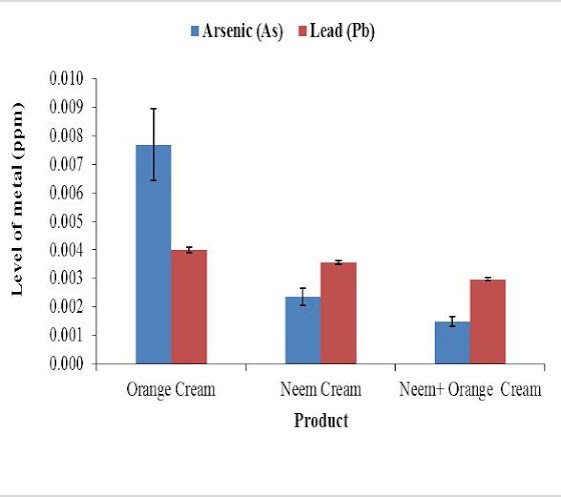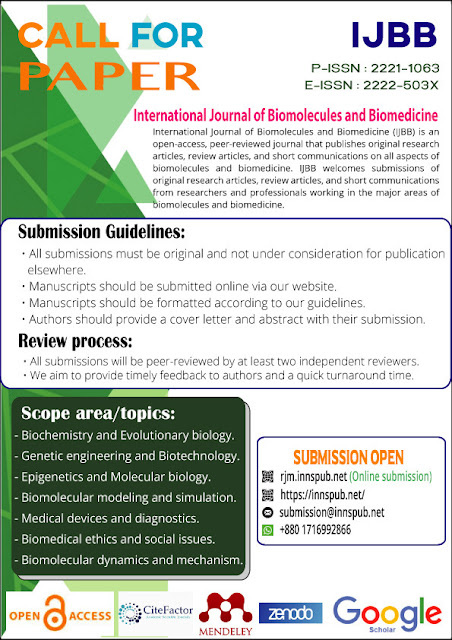Godfred Yaw Boanyah, Ruth Brenyah, and Precious Bondzie-Quaye from the different institute of Ghana and China, wrote a research article about Assessing Lead and Arsenic in Natural Mosquito Repellents,entitled "Evaluation of lead and arsenic content of Azardirachta indica seed oil and Citrus sinensis peel oil creams as mosquito repellent ."this research paper published by the International Journal of Biomolecules and Biomedicine (IJBB). an open access scholarly research journal on Biomedicine, under the affiliation of the International Network For Natural Sciences|INNSpub, an open access multidiciplinary research journal publisher.
Abstract
There is an increase preference for plant-based
repellents due to their effectiveness, environmentally friendliness and
biodegradable nature. It is therefore necessary to ascertain the safety of
these repellents by analysing their heavy metal content. This study has shown
that lead and arsenic content of Azadirachta indica seed oil cream
and Citrus sinensis peel oil cream as mosquito repellent is
insignificant and therefore very safe for use according to the Ghana
Standard Authority specification. These results provide new insight into the
safety of these natural mosquito repellents.
Read more: Mangrove Ecosystem Values in Day-asan, Surigao City | InformativeBD
Introduction
The use of repellent is an effective and reliable
method used in breaking Human-vector transmission cycle of pathogens (Hazarika et
al., 2012). Additionally, the application of repellent on clothing and bed nets
have shown excellent results in Africa, thus, conferring protection to the
individual using them (World Health Organization., 2017; Njumkeng et al.,
2019). Moreover, topical repellent is one of the most dependable ways of
controlling outdoor biting of mosquitoes especially in rural and farming
communities (Wilson et al., 2014).
However, the heavy metal constituent of naturally
manufactured repellent creams could be toxic and in turn defeat their overall
safety purpose. Exposure of the skin to arsenic can cause a variety of benign
skin lesions including hyperpigmentation and hyperkeratosis according to the
findings of Bernstam et al. (2002). It was indicated in a recent research that
developing countries have high environmental pollution of Lead which may be
absorbed by plants from which these natural repellents are made from. Organic
Lead may be absorbed directly through the skin and its effects are devastating.
High levels of lead in repellents when inhaled can result in decreased
performance in some tests of cognitive performance that measure functions of
the nervous system (Wani, Ara and Usmani, 2015).
In the last two decades, an intensive effort has
been made by several researchers to investigate the safety of diethyltoluamide
(DEET), one of the most widely used and reliable insect repellents
available(Goodyer and Behrens, 1998). However, many users of repellent are
still concerned about the safety use of DEET (Shukla, Wijayapala and Vankar,
2018). Furthermore, the easily biodegradative nature of plant-based repellents
and friendliness to the environment has added to their preference by customers
in recent years (Ketkar and Ketkar, 2005; Tripathi et al., 2016) but the
toxicity of some heavy metals in these natural topical repellents have not been
given much attention. This study seeks to evaluate the Arsenic and lead content
of Azadirachta indica seed oil Cream and Citrus sinensis peel oil cream as
mosquito repellent and as as well compare them to the standard maximum
allowable concentration requirement of these metals in topical repellents.
Reference:
Bernstam L. 2002. ‘Effects of arsenic on human keratinocytes: Morphological, physiological, and precursor incorporation studies’, Environmental Research. Academic Press 89(3), pp. 220-235.
Goodyer L, Behrens RH. 1998. The safety and toxicity of insect repellents. The American journal of tropical medicine and hygiene 59(2), pp.323-324.
Hazarika S. 2012.
‘Repellent Activity of Some Essential Oils Against Simulium Species in India’,
Journal of Insect Science. Oxford University Press (OUP) 12(5), pp.
1-9.
Ketkar CM, Ketkar MS. 2005.
‘Soap production from mixtures of neem oil with other non-edible or edible oils’,
in The Neem Tree: Source of Unique Natural Products for Integrated Pest
Management, Medicine, Industry and Other Purposes. Weinheim, FRG: Wiley-VCH
Verlag GmbH & Co. KGaA pp. 549-554.
Limonene C,
Bunsen G, Receiver C. 2009. ‘Extracting limonene from
oranges by steam distillation’, Advancing the Chemical Science, (Vii) pp.
41-44.
Njumkeng C. 2019.
‘Coverage and usage of insecticide treated nets (ITNs)
within households: Associated factors and effect on the
prevalance of malaria parasitemia in the Mount Cameroon area’, BMC Public
Health 19(1), p. 1216.
Shukla DK, Wijayapala
S,Vankar PS. 2018. ‘Effective mosquito repellent from plant based
formulation’, Population dynamics of Aedes mosquito larvae from peridomestic
water bodies 5(1), pp. 19-24.
Tripathi AK, Upadhyay
S, Bhuiyan M, Bhattacharya PR. 2009. A review on prospects of essential
oils as biopesticide in insect-pest management. Journal of Pharmacognosy and
phytotherapy 1(5), pp.52-63.
Wani AL, Ara A, Usmani
JA. 2015. ‘Lead toxicity: A review’, Interdisciplinary Toxicology 8(2), pp.
55-64.
Wilson AL. 2014.
‘Are topical insect repellents effective against malaria in endemic
populations? A systematic review and meta-analysis’, Malaria Journal 13(1), p.
446.
World Health Organization. 2017. Report of the twentieth WHOPES working group meeting. Geneva. Available at: http://www.who.int/whopes/en











%20in%20full.JPG)


0 comments:
Post a Comment